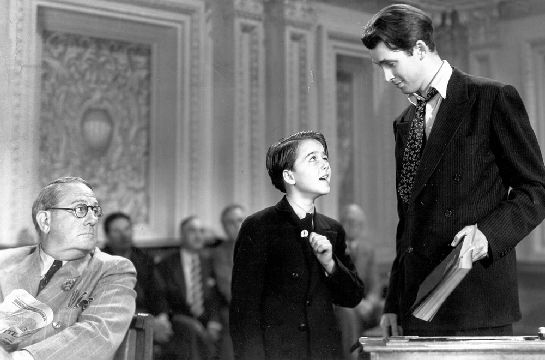Mr. Smith Goes to Washington (1939) 
“Romance, drama, laughter and heartbreak … created out of the very heart and soil of America … by a great director and cast!”

Director: Frank Capra
Cast: James Stewart, Jean Arthur, Claude Rains
Synopsis: A naive man is appointed to fill a vacancy in the US Senate. His plans promptly collide with political corruption, but he doesn’t back down.
Was anyone ever better than Jimmy Stewart at playing the innocent abroad slowly having the scales fall from his eyes? In Mr. Smith Goes to Washington the clean-cut 29-year-old Stewart plays a doe-eyed naif with a touching eagerness and desire to please that is both endearing and dispiriting for the audience. We know what Mr. Smith doesn’t – the Machiavellian intrigues that have propelled him to the Senate to become a pawn in the hands of more seasoned campaigners and their big-business backers.
Following the death of the incumbent senator, Jefferson Smith (Stewart) finds himself to be the United States’ newest Senator. Initially, Smith is too naïve and idealistic to realise that he has been placed there by unscrupulous tycoon Jim Taylor (Edward Arnold), who needs to ensure his plans for a new damn at Willets Creek are passed by around Willets Creek – he hopes to persuade the government to build a boys camp there – and when he learns of Taylor’s plan, and the obscene profit he and apparently honest senator John Paine (Claude Rains) stand to make from it, Smith decides to take a stand against their corruption.
Mr. Smith Goes to Washington is high quality entertainment which takes a commonly used theme that was tired even back in 1939 – that one little man can ‘make a difference’ no matter how the odds are stacked against him. In a way, that’s an idea that is as idealistic as Smith himself, but Capra couples this idealism with a subversive subplot which pointedly illustrates how easy it is for the profiteers of government to prevent the truth from reaching the American people – or at least was before the internet age. Of course, that’s all part of democracy: the right for expression and the opportunity to stifle it are offspring from the same womb.
The character of John Paine, a highly esteemed elder statesman, played with precisely the right level of studied dignity by Claude Rains, is by far the most interesting character in the movie. Smith’s character undergoes a predictable arc, and Eddie Arnold’s rascally businessman is almost cartoonish in his villainy, but Paine is a man in, well, pain. When an outraged Smith confronts Paine about his involvement in the dam scheme, Paine delivers a key speech in which he explains the level of compromise required in order to achieve good deeds. Ssmith isn’t convinced and, for al his earnestness, we can see that Paine knows he’s fooling himself and his sold out his high principles in return for status and a level of power. He’s a man being prodded and poked towards an uncomfortable crossroads he at which he is reluctant to arrive.
The cast of Mr. Smith Goes to Washington reads almost like a Who’s Who of Hollywood’s golden era – or at least of its character actors. In addition to Edward Arnold and Rains, we have the roguish Thomas Mitchell playing Diz Moore, the semi-alcoholic journalist with twinkle in his eye and a secret crush on leading lady Jean Arthur’s Clarissa Saunders, the PR girl tasked with keeping Smith on the straight and narrow after he inadvertently feeds the press with a mountain of damaging quotes during his first press conference. Guy Kibbee is the hapless Governor Hubert Hopper, the man who comes to regret dreaming up the idea of electing Smith. Also in the sterling cast are foghorn-voiced Eugene Pallette, Beulah Bondi, H. B. Warner, Harry Carey, Astrid Allwyn and Ruth Donnelly. With a cast like that, even if the movie was a clunker – which it isn’t – it would still be worth watching.
(Reviewed 18th August 2012)
httpv://www.youtube.com/watch?v=sm9qaEJ3MBc
